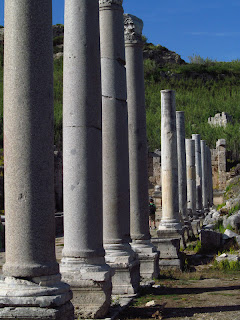Ataturk, the founder of the Modern Turkish Republic, established the Grand National Assembly on April 23rd, 1920. In 1921 it became "Children's Day, for who better than children represent the future of a country.
The event went pretty much as I expected - a lot of waiting around in the sun. Even still, it was a lot of fun to be part of the celebration.
The Evergreen Students did well. It was unfamiliar to them to march in step and in line, but they got into the role and did well.
Jacob, Ryan, and Alec with the Turkish girls.
Kids trying to find some shade.
There were 5000 students involved in the event. Luckily our students did not have to sing a solo performance in front of the governor, as originally planned.
We were involved in the parade and singing from 9 AM to noon. Then after lunch, we headed for the Roman theater in Aspendos, about an hour outside of Antalya.
The theater seats about 10,000 people (9) steps from bottom to top). Though originally a Greek theater, there is hardly anything left from that age. The city was founded around 1000 BCE and came under Persian domination about 500 years later. Alexander marched through at 333BCE, and 190 BCE the city surrendered to the Romans. The current Roman theater is 1800 years old, from the time when the Romans were feeding Christians to the lions. About a hundred years later, when the Roman empire adopted Christianity, the theater started to die (according to Yavoz, our guide) because the Christians didn't want to step foot in the theater where their grandparents had died.
The theater is used for performances during the summer months. Yavuz arranged for my student Lara to perform a short concert (two songs). She received huge cheers from the Turks and a Korean group in the theater at the time, who demanded she do an encore.
Trip Leader Eli listening to Lara play.
We decided to try something different during today's tour. When I first get to an historic site, I don't want to wait and listen to a lot of history from a tour guide about the place. I want to rush in and explore. So we asked the student to explore in groups of three and come up with questions while doing this. Then we all met with Yavuz afterwards and asked questions. It worked out much better this way.
About 30 minutes from Aspendos is the ancient city of Perge. Originally a Greek city founded around 1000 BCE, Perge also experienced the Persians, Greeks and Romans around the same time as Aspendos. Supposedly, St. Paul traveled to Perge in 46 CE. In the next couple of centuries it grew into one of the most beautiful cities in all of Anatolia.
During the reign of Constantine the Great (324-337 CE) Perge became an important center of Christianity. Perge lost all of its power during the Arab raids of the 7th Century, when many of its inhabitants moved to Antalya. After the collapse of the Roman empire, Perge remained an inhabited city through the Seljuk times, and then was gradually abandoned.
KJ posing
a sheep herder and sheep wandering through the ruins.
Alec, grace and Gray walking through the ruins.
Mary, our doctor and chaperone, Alicia, another trip leader, and Christine, another parent chaperone.
Emily and Mary






















No comments:
Post a Comment